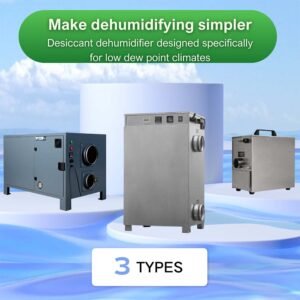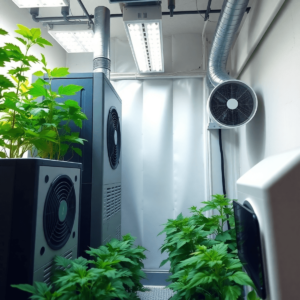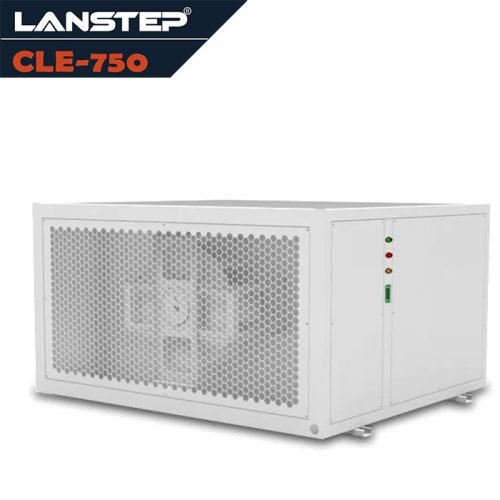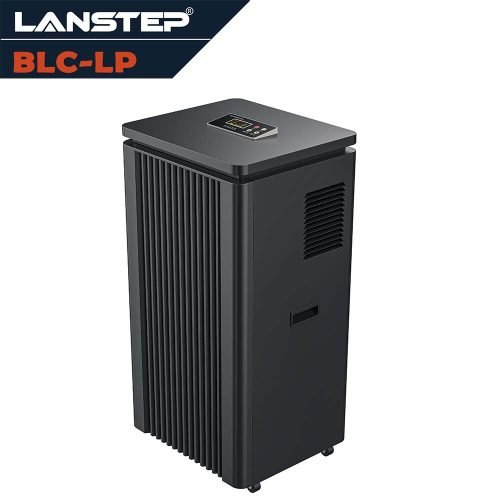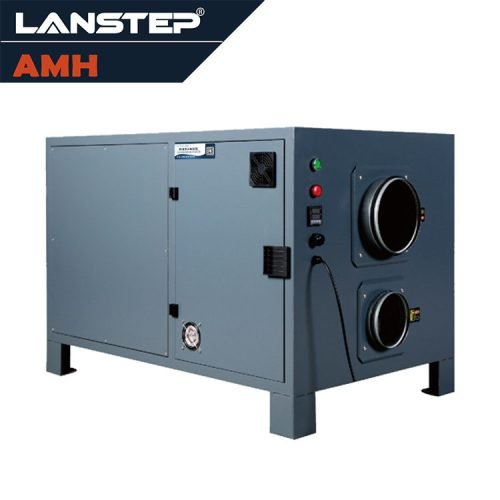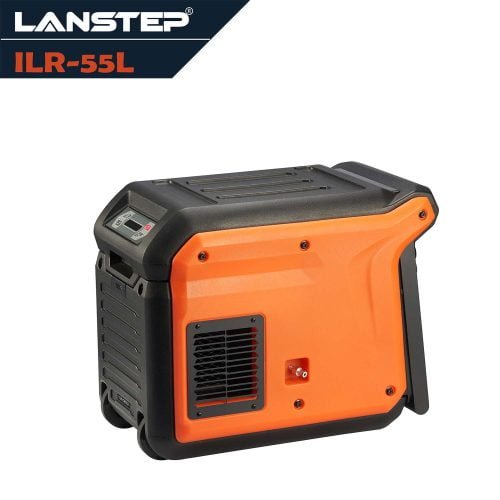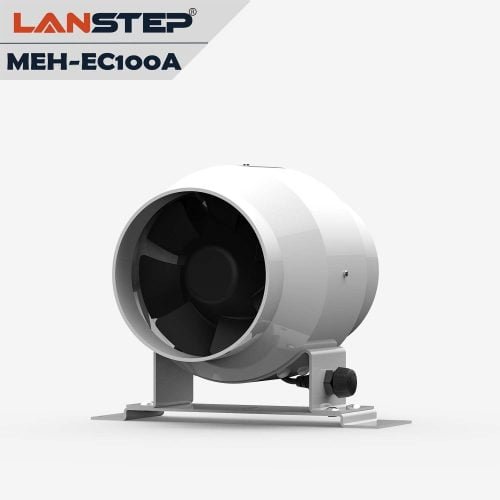Introduction
Vapor Pressure Deficit (VPD) is an important concept in modern agriculture and horticulture. It plays a crucial role in keeping plants healthy and protecting them from pests and diseases.
VPD measures the difference between the actual amount of water vapor in the air and the maximum amount it can hold at a specific temperature. This measurement helps us understand the environmental conditions that affect how plants function.
Why VPD Matters for Pest Management
Optimizing VPD levels can greatly benefit integrated pest management. By creating an environment with ideal VPD conditions, growers can improve both plant health and pest resistance. This makes it harder for pests to infest crops and for diseases to spread.
Pests and diseases are major challenges in farming. They can lower the quality of yields and reduce productivity. Relying solely on traditional methods to control these threats often isn’t enough, especially with pests becoming resistant and environmental factors changing.
This is where VPD management comes in as a powerful preventive tool. By manipulating humidity and temperature—two key factors that determine VPD—growers can create conditions that discourage pests from multiplying while also promoting healthy plant growth.
Beyond Pest Control: Preventing Diseases through Environmental Management
Using VPD management not only helps with controlling pests but also prevents diseases by managing the environment. This approach combines old-fashioned methods with new technology to tackle cultivation problems.
In this article, we’ll explore how maintaining optimal VPD levels supports this comprehensive strategy. We’ll see how traditional pest control methods work alongside advanced tools like greenhouse humidifiers and dehumidifiers to create better growing conditions for plants.
By understanding the relationship between VPD, plant health, and pest/disease management, we can develop sustainable agricultural practices that benefit both crops and ecosystems.
Understanding Vapor Pressure Deficit (VPD)
Vapor Pressure Deficit (VPD) is an important concept for understanding plant health and environmental control. It measures the difference between the actual moisture in the air and the maximum amount of moisture the air can hold at a specific temperature. This measurement is important because it directly indicates how much drying power the air has on plants.
Why VPD Matters in Plant Physiology
To effectively manage VPD, it’s essential to understand moisture content and transpiration processes. Transpiration is when plants release water vapor into the atmosphere, and its rate is greatly influenced by VPD levels. When VPD is high, plants lose water more quickly, which increases their stress levels and makes them more vulnerable to pests and diseases.
High VPD conditions can lead to:
- Increased plant stress: Rapid transpiration rates cause dehydration.
- Susceptibility to pests and diseases: Stressed plants become easier targets.
By maintaining optimal VPD balances, we ensure that plants can retain enough water for important processes like nutrient absorption and photosynthesis. This balance is crucial for promoting healthy plant growth and reducing vulnerabilities caused by stress.
How to Lower VPD
To lower VPD, we need to increase humidity levels in controlled environments such as grow rooms or greenhouses. Here are some strategies:
- Misting: Regularly misting plants raises humidity, which helps reduce VPD.
- Humidifiers: These devices systematically increase the moisture content in the air, thus lowering VPD.
By implementing these methods, growers can create environments where pest pressures are minimized because the plants are healthier and less stressed.
The Impact of VPD on Key Plant Processes
VPD affects several important physiological processes:
- Transpiration: As mentioned earlier, this process is directly linked to VPD levels.
- Nutrient Absorption: Higher transpiration rates can enhance nutrient uptake but also risk nutrient imbalances if not properly managed.
- Photosynthesis: Maintaining an optimal VPD supports efficient photosynthesis by ensuring there is enough water available for gas exchange.
By understanding and managing VPD effectively, growers can create environments that promote sustainable plant health and resilience against pest pressures. This knowledge allows us to go beyond traditional cultivation methods and embrace innovative agricultural practices.
Optimal VPD Ranges for Pest Control
Understanding the ideal VPD range is crucial for effective pest management in controlled environments. Different growth stages of a plant, whether it’s in the vegetative or flowering phase, have specific needs that can affect how vulnerable they are to pests. By adjusting the VPD values, we can meet these requirements and also make the environment less favorable for pests to thrive.
Exploring Growth Stages and VPD
Vegetative Stage
During this phase, maintaining a VPD range typically between 0.8 to 1.2 kPa is often recommended. This range promotes robust growth by ensuring efficient transpiration and nutrient uptake without imposing excessive stress on the plant.
Flowering Stage
As plants transition into the flowering stage, the ideal VPD might shift slightly higher, ranging from 1.0 to 1.5 kPa. This adjustment supports optimal flower development while still safeguarding against potential pest infestations.
Dual Benefits of Optimal VPD
Adjusting VPD within these ranges offers dual benefits:
- Enhanced Growth: Plants perform physiological processes more efficiently under optimal VPD levels, leading to healthier and more vigorous growth.
- Pest Mitigation: A well-maintained VPD reduces conditions that pests thrive in, such as excessive humidity, which can lead to infestations.
High vs. Low VPD Levels: A Delicate Balance
While maintaining optimal VPD is essential, understanding the effects of high and low VPD levels on plant health and pest control is equally important.
High VPD Effects
Elevated VPD levels may induce stress, causing plants to close their stomata to prevent water loss. This results in reduced transpiration and nutrient absorption rates, making plants more vulnerable to diseases and pests as their defense mechanisms weaken.
Low VPD Risks
Conversely, low VPD levels can lead to excessive humidity around the leaf surface, providing an ideal breeding ground for mold and other pathogens. The risk of fungal diseases like powdery mildew increases significantly under such conditions.
By navigating these nuances with precision, cultivators can harness the power of optimal VPD management, striking a balance that promotes vigorous plant health while simultaneously deterring pests.
Disease Prevention Through Environmental Management Strategies
In the complex process of plant growth and health, keeping Vapor Pressure Deficit (VPD) levels just right is crucial for preventing humidity-related diseases like mold and mildew. Understanding how to manage VPD effectively shows us that we can control the environment to reduce the conditions that promote these fungal threats. By adjusting VPD levels, we not only stop diseases from occurring but also improve the overall health of our crops.
Key Strategies for Disease Prevention:
- Controlled Humidity Levels: Mold and mildew thrive in specific humidity conditions. By managing VPD to maintain optimal humidity, we can significantly reduce the incidence of these diseases. Utilizing advanced solutions like CLE Series Dehumidifiers, which provide energy-saving, deep dehumidification and maintain ideal humidity levels, can be instrumental in this aspect.
- Temperature Regulation: Ensuring a stable temperature range complements humidity control, making environments less hospitable to pathogens.
- Air Circulation Enhancement: Adequate airflow prevents stagnant moisture, which is crucial in maintaining a balanced microclimate unfavorable to pests and diseases.
Implementing environmental management strategies goes beyond simply adjusting numbers; it involves creating an ecosystem where plants can thrive while making it difficult for pests to survive. This approach not only curbs pest populations but also strengthens plant health through natural defenses.
Balancing Humidity Control with VPD-Based Pest Prevention:
 Finding the right balance between humidity control and VPD management helps plants become more resilient against both diseases and pests. By understanding how plant physiology interacts with environmental factors, growers can design systems that shield against external threats while nurturing internal strengths.
Finding the right balance between humidity control and VPD management helps plants become more resilient against both diseases and pests. By understanding how plant physiology interacts with environmental factors, growers can design systems that shield against external threats while nurturing internal strengths.
- Disease Suppression: Optimal VPD levels minimize excessive moisture, thereby reducing the likelihood of fungal diseases.
- Pest Deterrence: Environments tailored to ideal VPD ranges are less conducive to pest infestations, as many pests prefer specific humidity levels.
These strategies involve recognizing how important environmental conditions are in effectively managing both pests and diseases. It requires understanding how changing one factor can impact another, which calls for a comprehensive perspective.
Practical Strategies for Effective Environmental Management:
Putting theory into action means using various techniques:
- Regular Monitoring: Utilize hygrometers and thermometers to keep a constant check on environmental conditions.
- Technology Integration: Implement automated systems that adjust climate variables in real-time, ensuring consistent VPD maintenance.
- Data Analysis: Continuously analyze climate data trends to forecast potential issues before they manifest into visible problems.
By adopting these measures, growers can create environments that naturally repel pests while promoting vigorous plant health. Combining integrated pest management with VPD control offers twofold benefits—protection against pathogens along with improved growth dynamics.
Ultimately, mastering these environmental management strategies not only shields crops from immediate dangers but also lays down a framework for sustainable agricultural practices prioritizing both plant well-being and ecological equilibrium.
Balancing Plant Health with Pest Resistance: A Holistic Approach to Integrated Pest Management (IPM)
Utilizing Vapor Pressure Deficit (VPD) management as part of Integrated Pest Management (IPM) offers a flexible strategy for cultivating robust and pest-resistant plants. By understanding and applying optimal VPD levels, we can significantly enhance plant strength, making them inherently less susceptible to pests and diseases.
Optimal VPD Ranges for Enhanced Resilience
The secret to boosting plant health lies in meticulously controlling VPD levels. This regulation ensures that plants are not subjected to stress from excessive or insufficient moisture, both of which can render them vulnerable to various threats. Maintaining specific VPD levels tailored to different growth stages aids in plant flourishing, promotes healthy processes, and fortifies their natural defenses against pests and pathogens. This approach aligns with the findings in a study published by the American Society of Agronomy, which emphasizes the significance of such environmental controls in agricultural practices source.
Creating a Balanced Ecosystem with IPM
Effective environmental management extends beyond merely disease prevention; it fosters a balanced ecosystem that facilitates natural pest control. By merging VPD management with IPM strategies, farmers can cultivate an environment that minimizes disease incidence while promoting beneficial organisms that naturally curtail pest populations. This synergy not only reduces reliance on chemical interventions but also enhances biodiversity within cultivation areas.
Integrating VPD-Based Strategies
Incorporating VPD management into IPM practices is an astute way to nurture plants:
- Environmental Control: Adjusting humidity and temperature settings in growing environments such as rooms or greenhouses helps maintain VPD within ideal ranges, establishing conditions that are unfavorable for pests yet conducive for plant growth.
- Holistic Health Focus: Prioritizing plant health alongside pest resistance underscores the necessity for comprehensive strategies that view these objectives as interconnected components of successful farming.
- Technological Implementation: Leveraging advanced climate control technologies enables real-time monitoring and adjustment of environmental factors, enhancing precision in maintaining optimal VPD levels.
Enhancing Both Plant Health and Pest Resistance
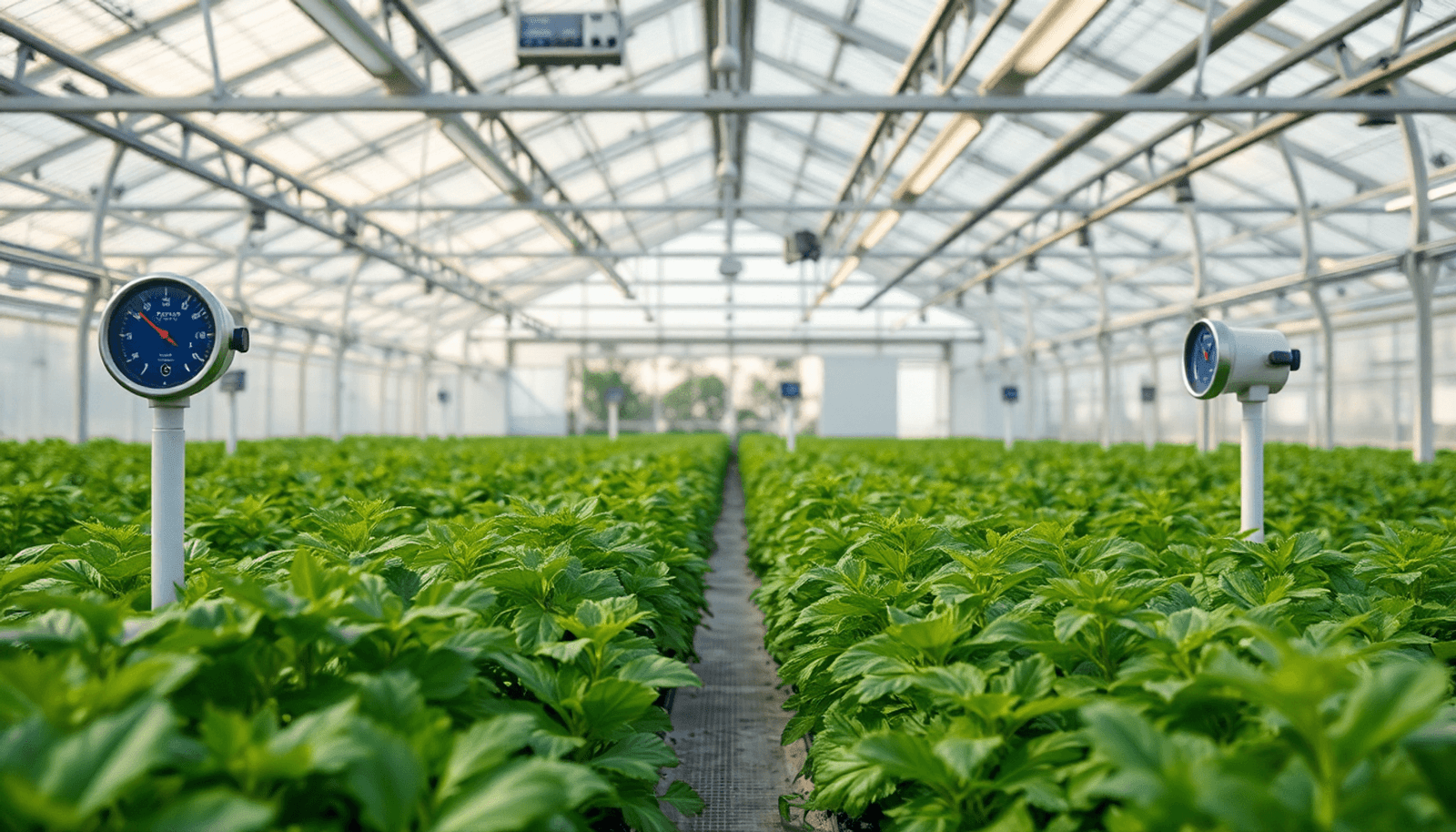 To achieve these dual objectives, various strategies can be employed:
To achieve these dual objectives, various strategies can be employed:
- Continuous Monitoring: Utilize hygrometers and thermometers to keep track of environmental conditions, ensuring they conform to the desired VPD ranges.
- Automated Systems: Deploy systems capable of making real-time adjustments based on environmental data analytics.
- Data Analysis: Regularly analyze collected data trends to proactively address potential issues before they escalate into significant problems.
This all-encompassing approach underscores the importance of considering both plant health and pest resistance when devising an IPM plan. By integrating these elements with cutting-edge technology and strategic insight, farmers can cultivate healthier plants that naturally repel pest invasions, thereby achieving a harmonious balance between thriving crops and sustainable practices.
Steps to Monitor and Manage VPD Levels in Grow Rooms or Greenhouses
A good understanding of Vapor Pressure Deficit (VPD) management can be key to achieving optimal plant health and preventing pest infestations. Mastering the art of VPD monitoring requires accuracy, the right tools, and a strategic approach. Let’s explore how you can effectively monitor and manage VPD levels to create a thriving cultivation environment.
Key Monitoring Techniques
1. Utilization of Hygrometers and Thermometers
These instruments are essential in maintaining an accurate read on both temperature and humidity—two crucial factors that influence VPD. By continuously monitoring these variables, you ensure that VPD levels remain within optimal ranges conducive to plant growth.
2. Automated Climate Control Systems
With advancements in technology, automated climate control systems offer growers the ability to adjust humidity and temperature in real time. These systems enhance precision in managing VPD by responding dynamically to environmental changes, ensuring conditions are consistently favorable for plant health.
3. Regular Data Analysis
Analyzing VPD data trends allows growers to identify potential issues early. By examining historical data, you can detect patterns that may indicate deviations from ideal conditions, enabling timely interventions that promote robust plant health and deter pests.
Calculating and Monitoring VPD Effectively
To accurately calculate and manage VPD levels, consider the following steps:
- Measure Temperature and Humidity
- Use reliable hygrometers and thermometers placed at various points within the grow room or greenhouse to obtain comprehensive data on environmental conditions.
- Calculate VPD
- The equation for VPD considers both temperature and relative humidity. Tools such as digital calculators or software applications specifically designed for horticultural use can simplify this calculation, providing instant insights into your environment’s status.
- Implement Real-Time Monitoring Tools
- Leverage technology by employing sensors that continuously feed data into a central system. This setup not only automates the process of tracking changes but also alerts you to any deviations from set parameters.
- Adjust Environmental Controls Based on Data
- Use the insights gained from monitoring to make informed adjustments to your climate control systems, whether it’s increasing humidity via misting or adjusting temperatures through ventilation systems.
- Invest in Advanced Technologies
- Consider integrating advanced dehumidification solutions like LANSTEP’s innovative products, which allow precise humidity control even in challenging environments such as greenhouses. These technologies not only enhance moisture extraction but also optimize energy efficiency.
For instance, the CLE500 efficient grow room dehumidifier removes up to 500 pints of moisture per day, ensuring optimal humidity control for healthier plant growth. Similarly, the CLE210 high-efficiency dehumidifier is designed exclusively for grow rooms and removes up to 210 pints per day at RH60% 80℉.
By implementing these strategies, you empower yourself with the ability to maintain an ideal growing environment where plants thrive while pests struggle to gain a foothold.
Using Technology for Effective Pest and Disease Prevention Through VPD Management
In modern agriculture, combining technology with traditional methods offers a revolutionary way to manage pests and diseases. Vapor Pressure Deficit (VPD) is crucial in this process, acting as a key factor for both pest control and disease prevention by using precise environmental management.
Using Sensors and Data Analysis
Accurate Monitoring: The use of sensors in farming environments has transformed how we track VPD levels. These devices constantly collect data on temperature and humidity, which are critical factors affecting VPD. With real-time monitoring, farmers can maintain specific VPD ranges tailored for different growth stages, directly improving pest control effectiveness.
Insights from Data: Advanced data analysis turns raw sensor information into practical insights. By studying patterns and irregularities, farmers can proactively tackle potential problems, ensuring that conditions remain favorable for plant health while reducing pest pressure.
Automated Climate Control Systems
 Creating Ideal Conditions: Automated climate control systems represent technological advancement. They dynamically adjust environmental factors, keeping precise VPD levels that reduce disease risks. Through these systems, farmers can create settings that hinder pathogen growth while promoting healthy plant development.
Creating Ideal Conditions: Automated climate control systems represent technological advancement. They dynamically adjust environmental factors, keeping precise VPD levels that reduce disease risks. Through these systems, farmers can create settings that hinder pathogen growth while promoting healthy plant development.
Using Predictive Modeling Tools: Predictive modeling tools provide an extra level of foresight. By forecasting how changes in environmental conditions impact plant health and pest resistance, these tools assist farmers in making informed choices that balance plant vitality with pest management strategies.
Advanced Technologies in Action
Automated HVAC Systems and Dehumidifiers: Within this innovative framework, technologies like automated HVAC systems play a crucial role. These systems ensure consistent air movement and temperature control, essential for maintaining steady VPD levels. Dehumidifiers equipped with advanced features excel in efficiently removing excess moisture, thus preventing conditions favorable to mold and mildew.
Optimizing Energy Use: Energy-efficient solutions represent a significant advancement in sustainable agriculture. Their ability to function effectively at low temperatures while minimizing energy usage aligns perfectly with the goals of maintaining optimal VPD for pest and disease prevention.
The combination of technology and traditional farming methods marks a new era in crop management. By using advanced tools—sensors, automated systems, predictive models—farmers not only improve their capability to manage VPD but also strengthen their crops against pests and diseases. This comprehensive approach fits seamlessly into broader strategies like Integrated Pest Management (IPM), ensuring sustainable production while protecting our food supply chain.
Conclusion: Mastering VPD as a Key Strategy for Sustainable Pest and Disease Prevention in Cultivation Systems
In the ever-changing world of sustainable agriculture practices, VPD-Based Pest and Pathogen Prevention stands out as an essential strategy. By implementing optimal VPD ranges, we can enhance plant resilience against the myriad challenges posed by pests and diseases.
1. Optimal VPD Ranges for Pest Control
Establishing precise VPD levels acts as a shield, minimizing pest susceptibility across different growth stages. This strategic control fosters a robust plant environment less conducive to pest invasions.
2. Disease Prevention Through Environmental Management
Effective management of Vapor Pressure Deficit plays a crucial role in reducing crop disease incidences. By maintaining an environment that discourages humidity-related diseases like mold and mildew, we promote healthier crops.
3. Balancing Plant Health with Pest Resistance
Integrating VPD management with pest resistance strategies ensures that plants not only survive but thrive. Such integration highlights the dual benefits—enhancing overall plant health while fostering sustainable agriculture practices.
The synergistic relationship between effective pest control measures and maintaining a balanced growing environment is undeniable. Through strategic manipulation of VPD, we establish a harmonious ecosystem where plants can flourish resiliently amidst challenges. As we continue to innovate and refine our approaches, mastering VPD remains at the forefront of cultivating success in modern agriculture systems.
FAQs (Frequently Asked Questions)
What is Vapor Pressure Deficit (VPD) and why is it important for plant health?
Vapor Pressure Deficit (VPD) measures the difference between the moisture in the air and the maximum moisture the air can hold at a given temperature. It is crucial for plant health as high VPD can lead to increased plant stress, making them more susceptible to pests and diseases.
How can I lower VPD in my greenhouse?
To lower VPD, consider strategies such as increasing humidity levels through misting or using humidifiers. These methods enhance plant health by reducing stress and minimizing pest pressure.
What are the optimal VPD ranges for pest control during different growth stages?
Maintaining optimal VPD ranges varies depending on the growth stage of plants, such as vegetative or flowering. These ranges help minimize pest susceptibility while fostering healthy plant development.
How does environmental management contribute to disease prevention in cultivation?
Effective environmental management, including humidity control, creates unfavorable conditions for pests and reduces humidity-related diseases like mold and mildew. This promotes overall plant health and resilience against diseases.
What techniques can I use to monitor and manage VPD levels in my grow room?
Utilize hygrometers and thermometers to continuously monitor temperature and humidity levels. Implement automated climate control systems to adjust these parameters in real-time, ensuring VPD stays within optimal ranges.
How can technology assist in maintaining optimal VPD levels for pest and disease prevention?
Leveraging advanced technologies such as sensors, data analytics, and automated climate control systems allows growers to monitor and maintain optimal VPD levels effectively. Predictive modeling tools can also help balance plant health with pest resistance for sustainable crop production.


